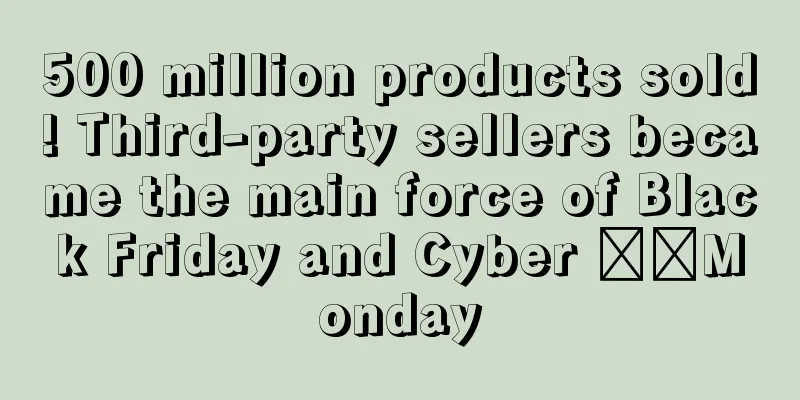Prime Day is set, but nearly 50% of sellers surveyed will not participate

|
This annual event has attracted much attention among sellers. However, after Amazon announced the promotion time, many sellers said that they did not have high expectations, and nearly 50% of the sellers interviewed said that they would not participate.
There are many factors that influence sellers’ decisions, including the profit after discounts during the promotion, buyers’ shopping desires, and the results of last year’s promotions. For example, during last year’s Prime Day, some sellers suffered from a sales slump after careful preparation, which inevitably hit their confidence.
However, judging from the overall situation this year, most sellers will still participate in this event. After the platform has been preheated many times, there will definitely be a huge influx of traffic at this sales node. Taking advantage of the popularity may usher in a small explosion of orders, so why not? The lack of enthusiasm of other sellers is also understandable. According to research institutions, Americans' consumption concepts have changed in the post-epidemic era. Three factors have emerged, such as "consumers are reducing spending and paying more attention to saving money", which may interfere with the performance of Amazon Prime Day, and sellers should also prepare rationally.
Nearly half of the sellers interviewed said they would not participate in the Member Day promotion
Many sellers are very happy that the time of Prime Day has been settled, and they can move forward with the next big promotion preparations. "To be honest, I am still looking forward to it. This is my first time to participate in Prime Day since I entered the industry. I heard that this is the second largest traffic gate after Christmas. I don't know whether I will be surprised or shocked." said a new seller.
But the attitude of old sellers is obviously different.
Een.com conducted a survey on the willingness to participate in Prime Day. When asked, "Will your company participate in this year's Prime Day promotion?", 50% of the sellers interviewed clearly stated that they must participate, after all, it is an annual event, but nearly 50% of the sellers said they would not participate.
The reasons why sellers decided not to participate in this promotion include: the promotion prices are too low to guarantee profits, lack of confidence in consumers' enthusiasm for shopping this year, and doubts about the effectiveness of the promotion due to the unsatisfactory promotion last year.
Currently, the submission window for coupons and Prime exclusive discounts is still open, and the scoring requirements for participating products are very loose, which gives most products a chance to participate, but both have specific requirements for the discount strength. Among them, coupons require the event price to be at least 95% off the current price, while Prime exclusive discounts require the event price to be at least 20% off the current price and meet the lowest price in the past 30 days.
However, there are not many products that still have a profit to advertise after a 20% price cut , so price and profit have become the main concerns of sellers participating in the event. In the eyes of many people, this big promotion may be a charity action, and the involution of categories will be further exacerbated. Some sellers even define it as a clearance day, implying that they can take the opportunity to clear out their inventory and forget about making profits.
A seller did the math on his previous experience, "Based on last year's experience, the number of orders increased threefold, the promotional price had to be 30% lower than the lowest price of the year, and then advertising fees increased threefold. Orders dropped sharply after the holidays, which means your sales volume for the next few days is concentrated on this day, with low selling prices and high advertising. In the end, you lose money instead of making a profit, and it's like doing charity." Under this emotion, the seller said he would not participate this year, and at most he would use it to clear inventory.
The widespread low-price sales have caused many sellers to lower their expectations for big sales.
According to the survey, about 60% of sellers did not have high hopes for the event and just participated with the attitude of giving it a try; about 30% of sellers had expectations and hoped for a small surge in orders; only less than 10% of sellers had high expectations for a surge in orders and had made sufficient preparations for it.
"I don't dare to expect anything, it's nothing more than doing charity to make the data look less embarrassing." A seller said. People reduced their shopping before the membership day, and some shopping demand after the membership day has been overdrawn. Comprehensively calculated, some sellers may not see a significant increase in overall sales after a busy promotion; and the discounted prices during the event have led to meager profits or even no profits for many products, which obviously dampened the enthusiasm of sellers.
The ultimate goal of business is to make a profit, and some sellers will not do business at a loss. Bedsure, a cross-border e-commerce brand under Shangbai Global that focuses on home furnishings, has expanded its business from Amazon's European and American sites to emerging sites such as India. Regarding this big promotion, its CEO Zhu Xingjian said: "We will not engage in price wars, but we must prepare our bullets."
Since its inception, Amazon Prime Day has been a major event to supplement sales during the off-season. This year's Prime Day covers 24 sites, including the UK, the US, Australia, Canada, France, Germany, Italy, Japan, Sweden, Poland and Egypt, the most in history.
After months of sluggish sales, Amazon hopes to take advantage of this opportunity to boost performance by offering consumers a large number of rich and discounted products.
High conversion rate, Prime exclusive discounts are highly recommended
During the promotion, sellers can use several promotional methods including flash sales, coupons, etc. According to Amazon's reminder, the submission of coupons and Prime exclusive discounts is still open. The former can be submitted before July 11, and the deadline for the latter is subject to the background display.
How can we maximize the effectiveness of the several promotional methods provided by the platform? Based on past experience, most sellers use Prime exclusive discounts as their preferred participation method.
Among the sellers surveyed, 75% said they would use Prime exclusive discounts, 55% would use flash sales, 30% would use coupons, and another 9% would use store treasures.
Sellers have good reason to favor exclusive discounts.
One seller said that he prefers exclusive discounts. "Because Prime exclusive discounts are free promotional methods, if we sellers want to offer such discounts, Amazon will not charge any extra fees. And with this discount method, when a consumer searches for a product, the page that pops up will directly display the discounted price we give, as well as the normal selling price of the product. This method can directly give consumers a psychological comparison, increase their interest in continuing to browse our products, and help convert our on-site traffic."
The price comparison brought by exclusive discounts is very important for sales. At the same time, sellers do not need to pay extra activity fees for this, so it has become the first choice for many sellers to promote sales. In addition, coupons are also widely used. They have different effects from exclusive discounts, so some sellers will use them together to achieve a gain effect.
As the seller analyzed, exclusive discounts are only for Prime members, while coupons are more widely applicable. If you plan to reach as many consumers as possible, coupons will be a better choice. If the seller also attracts traffic from outside the site, a considerable proportion of traffic will come from non-Prime members, and coupons can convert better than exclusive discounts.
Of course, if sellers focus on improving conversion rates and orders to maintain product competitiveness, then exclusive discounts are more suitable for this promotion. "Prime discounts can increase the proportion of high-quality traffic and increase the probability of conversion, so if the conversion rate does not meet expectations after setting up coupons, you may want to try Prime discounts." said the seller.
During the Member Day event, coupons and Prime exclusive discounts will be marked with event logos, so consumers can clearly see the promotional products on the search results page, which will increase their desire to buy. The two are complementary in terms of usage effects, and working together will have a good effect.
However, any promotion is just a means. Without profit as a prerequisite, it is difficult for sellers to be motivated. One operator said that he only planned to offer an exclusive discount. The cost of flash sales was high, but if there was no profit, the boss would hold him accountable.
To a certain extent, sellers' wavering confidence in Member Day is closely related to last year's big promotion.
Seller: I was hurt by losing money for charity
At the beginning of last year, many sellers reported that orders were sluggish. Perhaps in order to boost morale, Amazon moved Prime Day forward to June.
When they learned that Prime Day would be brought forward, many sellers were ready to go. They adjusted their links, put up portraits of Bezos in their companies, and put up slogans promoting explosive sales, in preparation for the surge in orders.
Then when the Prime Day promotion started on Japan and Europe , some sellers were confused because it was not the same as the Prime Day they expected. Some sellers thought they had participated in a fake Prime Day. Since the Prime Day, ACOS has only increased, orders have not exploded at all, but ads have exploded first. Some sellers also reported that they couldn't sell even if they lost money for charity. Finally, some sellers put away their expectations and just hoped to use the Prime Day promotion to clear their inventory.
When it came to the much-anticipated Member Day promotion on the US site, most sellers still had slow orders. Compared with previous years when sellers excitedly posted their orders, sellers rarely posted their orders during last year's Member Day promotion.
Judging from the few feedbacks, most sellers' sales performance during the promotion was not good, and their sales volume was no different from their usual performance. Some sellers said frankly that the order volume was slightly higher than usual, but the profit was not as good as usual. Nearly half of the sellers interviewed said that sales were sluggish last year and they felt they had fallen into a trap; another 40% of sellers believed that sales performance was average, but basically in line with expectations.
In fact, last year's Prime Day, some sellers carried out "suicidal price cuts", and many products were sold at low prices. A wave of sellers set the discounts very low, which were jokingly called "charity discounts". Some sellers said frankly: I was hurt by doing charity at a loss, and everything was in vain without profit.
However, some sellers were lucky. One Amazon seller originally had 200 orders a day, but the number of orders on the first day of the promotion soared 8 times to 1,600. In addition, some home furnishing sellers also achieved good results.
It is understood that Amazon's total turnover on Prime Day 2021 reached US$11.2 billion, with more than 250 million products sold worldwide, and many hot-selling products appeared on multiple sites. For example:
The American station has electric water flossers, organic plant protein powder, health gene tests, and robot vacuum cleaners; The UK station has cordless stick vacuum cleaners, facial cleansers, and whiskey; all-in-one dishwashers, tablets, baby diapers at sites in Spain and Portugal; Barley tea and extra-strong sparkling water at the Japanese station; Coffee capsules, washing machine detergent, and electric toothbrush replacement heads at the Italian station; razor replacement blades and diapers at the French site; Smart lights, ketchup, laundry detergent ... in the Brazilian market
Through the hot-selling products at each site, we can see that global consumers still buy more daily necessities. Under the influence of the COVID-19 pandemic, people have reduced some non-essential expenses and spent more money on daily necessities.
In addition to daily necessities, it is worth noting that during last year's Prime Day promotion, Amazon sold approximately 600,000 backpacks, and back-to-school related products ushered in a wave of explosive orders.
This year, global consumers may spend more money on daily necessities, and sellers can refer to last year's hot-selling products to launch promotional activities. However, some new situations have also emerged this year, leading to new changes in the Prime Day promotion.
Prime Day this year will be different as consumers cut back on spending
Over the past two years, American consumers have cut their overall spending and their purchasing channels have largely shifted from offline to online shopping. During the COVID-19 pandemic, Amazon has been the largest shopping destination for Americans, surpassing physical store retail giants such as Walmart and Target, and far exceeding e-commerce platforms such as eBay and Etsy.
However, with the advent of the post-epidemic era, American consumers' consumption perspectives have also changed. This year's Prime Day will be different from previous years. Jungle Scout believes that the main reasons are as follows:
1. Consumers are spending less
Jungle Scout 's latest survey of 950 U.S. consumers shows that many are concerned about inflation , which has climbed to 75% over the past year. In response to rising prices for essentials such as fuel and groceries, consumers expect to spend less in 2022 as they try to save money on household purchases and save money for big-ticket items. The specific situation is:
38% of consumers are reducing their overall spending ; 72% of consumers said rising inflation is affecting their spending on consumer goods ; 70% of consumers will reduce impulse purchases in 2022 ; 52% of consumers are saving for a major purchase such as a new home or a vacation .
2. Consumers are more focused on saving money
Many Americans have experienced severe financial stress over the past two years, as they slowly changed their spending habits to adjust to income fluctuations, job losses and the economic uncertainty caused by the coronavirus pandemic . That could make Prime Day more appealing than before.
53% of consumers feel compelled to buy a product when offered a deal, coupon or discount code ; 47% of consumers will only buy discounted products ; 47% of consumers will only buy brands they like because they can afford it .
3. Consumers plan to spend more on home and self-care
The home improvement and home furnishing economy will thrive in 2022. Although some consumers have returned to their pre- pandemic lives, 60% of consumers still plan to spend more time at home in 2022.
50% of consumers are willing to spend more on housing compared to before 2020 ; 62% of consumers will focus on self-care and wellness products ; 61% of consumers prefer to cook at home rather than eat out at restaurants ; 45% of consumers are more interested in interior design and home decoration .
Amazon's Prime Day promotion has been held every year since 2015. The promotion has been extended from 24 hours at the beginning to two days. Not only has the duration become longer, the countries and regions participating in the Prime Day promotion have also expanded, and the platform's sales have also been increasing.
On July 15 , 2015 , Amazon launched its first Prime Day promotion, which lasted for 24 hours. Amazon's revenue during Prime Day 2015 even exceeded the record-breaking Black Friday sales in 2014. Global FBA sellers saw a 300% increase in sales, with 34.4 million items sold.
The total number of countries participating in the 2016 Prime Day promotion reached 10, Amazon's global sales increased by 60% compared to 2015, and orders from third-party sellers providing transactions increased nearly three times year-on-year.
In 2017, the number of countries participating in the Prime Day promotion increased from 10 to 12, the number of products sold increased by 50% compared to 2016, and the duration of the promotion increased from 24 hours to 30 hours, resulting in even greater sales growth for Amazon.
Having tasted the sweetness of extending the promotion period, Amazon went a step further in 2018 by increasing the duration of Prime Day promotion to 36 hours. The platform reaped great rewards, with Prime members worldwide purchasing more than 100 million products that year and small and medium-sized businesses generating revenue of more than US$1.5 billion.
In 2019 , Amazon extended the Prime Day promotion to 48 hours again, and its sales exceeded the combined sales of Black Friday and Cyber Monday in 2018. During the two-day promotion , consumers purchased more than 175 million items, generating more than $2 billion in revenue for third-party sellers.
In 2020 , due to the impact of the COVID-19 pandemic, Amazon postponed its Prime Day in the United States to October 13-14. Although many Americans reduced their consumer spending after the epidemic , Amazon still achieved new sales results in the 2020 promotion , with total sales reaching US$10.4 billion.
In 2021, Amazon moved Prime Day forward to June 21-22, earlier than any other year. During this year's promotion, Amazon 's total sales on Prime Day were only 6.1% higher than in 2020, far lower than the 17.3% predicted by a US market research company, and clearly fell short of expectations. Relevant data shows that before 2020, Prime Day grew by 50% or more each year.
Compared with previous years, Amazon's promotion of Prime Day in 2021 was not strong, with fewer slogans such as "the largest shopping event in Amazon's history" and fewer active displays of consumers snapping up heavily discounted goods. In addition, due to the impact of the epidemic and the shortage of goods caused by sellers' supply chain problems, many sellers' promotion performance was not ideal.
Looking back at last year's promotional performance, some sellers have reservations about this year's Prime Day , but the fact that the promotion returns to July this year may be a good sign. As an annual promotion, Amazon sellers who have the conditions can follow the platform's pace and try to move forward, which may usher in a surge in orders and add a touch of color to the off-season sales.
In addition, this year is also the first Prime Day for Amazon without founder Jeff Bezos at the helm. What kind of achievements will the current CEO Andy Jassy lead Amazon to achieve? This is worth looking forward to. Amazon Prime Day |
<<: Shenzhen cross-border e-commerce giant will be wholly acquired!
>>: Sold out! Another product is being urged to be restocked by consumers
Recommend
Zalando expands luxury goods category to capture fashion market
As the largest local e-commerce platform in Germa...
Another e-commerce platform in the United States is facing bankruptcy, and is the blame directed at Amazon?
The overseas market has been cold this year, with...
Wayfair builds new fulfillment center to enhance shopping experience
The epidemic has accelerated the development of o...
eBay reselling is booming, with more sellers turning to this business opportunity
Since the UK lockdown, the latest report data fro...
What is Dreamdata? Dreamdata Review, Features
Dreamdata is a B2B revenue attribution SaaS platf...
Chile's Black Friday sales reached 500 million, setting a new record!
Black Friday sales in the United States declined ...
What is Nobu? Nobu Review, Features
Nobu is a comprehensive cross-border e-commerce m...
TikTok once again won the global download volume crown in February and has the highest global revenue for 11 consecutive months!
According to data from mobile application data an...
XTransfer released its first export PMI. In April, the export of goods of Guangdong's small and medium-sized enterprises (B2B) showed an expansion trend.
Recently, XTransfer, a one-stop cross-border fina...
What is Guangxin Qianlian? Guangxin Qianlian Review, Features
Guangxin Qianlian focuses on interior furniture a...
What is Mulberry? Mulberry Review, Features
Mulberry , also known as Mulberry, is a British l...
What is FORZIERI? FORZIERI Review, Features
Founded in 1992, FORZIERI is an Italian one-stop l...
43% of Brits strongly regret using Amazon
According to foreign media reports, digital exper...
What is Wangdiantong? Wangdiantong Review, Features
Wangdiantong is an e-commerce ERP specially tailo...
Annual revenue exceeds 1.6 billion yuan, driven by strong sales of air fryers
In recent years, air fryers have become popular a...









